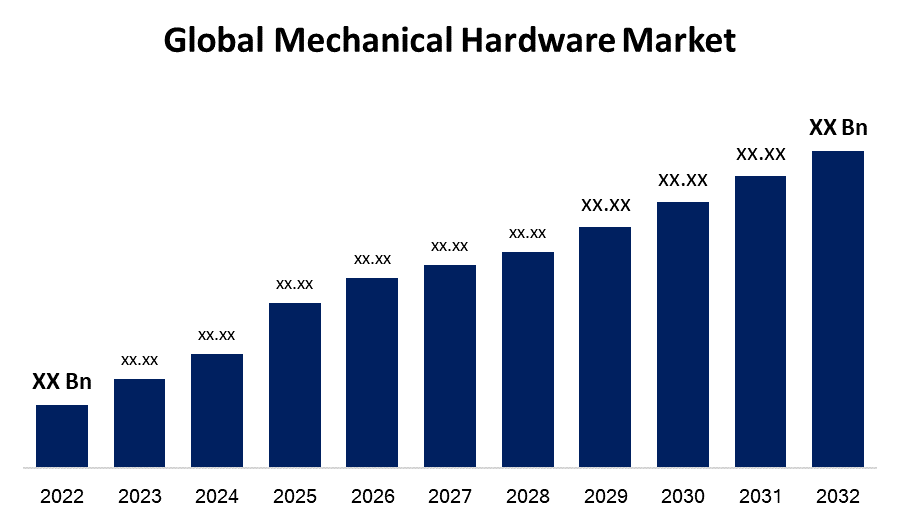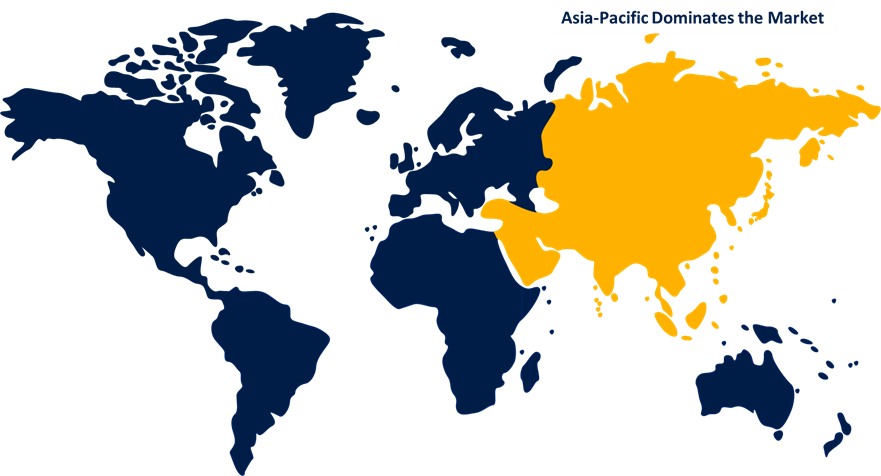Global Mechanical Hardware Market Size, Share, and COVID-19 Impact Analysis, By Component (Fasteners & Fixings, Bearing & Power Transmission, Springs & Wire Forms, Seals & Gaskets, Valves & Fittings, Pumps & Fluid handling, HVAC, Actuators & Motion Control, and Tools & Tooling Systems), By Application (Automotive, Aerospace & Defense, Industrial Machinery, Construction & Infrastructure, Energy & Power, Electronics, Oil & gas, and Others), and By Region (North America, Europe, Asia-Pacific, Latin America, Middle East, and Africa), Analysis and Forecast 2022 - 2032.
Industry: Machinery & EquipmentGlobal Mechanical Hardware Market Insights Forecasts to 2032
- The Global Mechanical Hardware Market Size was valued at USD XX Billion in 2022.
- The Market Size is Growing at a CAGR of XX% from 2022 to 2032.
- The Worldwide Mechanical Hardware Market Size is expected to reach USD XX Billion by 2032
- North America is expected To Grow the fastest during the forecast period.

Get more details on this report -
The Global Mechanical Hardware Market size is anticipated to exceed USD XX Billion by 2032, Growing at a CAGR of XX% from 2022 to 2032.
Market Overview
Mechanical hardware encompasses a wide range of components and systems used in a variety of industries, including automotive, aerospace, manufacturing, and construction. Bearings, fasteners, valves, springs, gears, and actuators are examples of these components. One of the key factors driving the growth of the global mechanical hardware market is the increasing demand from end-use industries. The automotive sector, in particular, has witnessed significant expansion, leading to a surge in demand for mechanical hardware components for vehicle manufacturing and assembly. Additionally, the growing aerospace industry, driven by rising air travel and defense spending, has contributed to the market's growth. Technological advancements and innovations have also played a crucial role in shaping the market. The development of lightweight and durable materials, such as advanced composites, has led to the production of high-performance mechanical hardware components. Furthermore, the integration of Internet of Things (IoT) technology in mechanical systems has improved operational efficiency and enabled predictive maintenance, creating new growth opportunities.
Asia Pacific has emerged as a dominant region in the global mechanical hardware market, driven by the presence of major manufacturing hubs, such as China, Japan, and South Korea. These countries have witnessed significant industrial growth, leading to increased demand for mechanical hardware.
Report Coverage
This research report categorizes the market for the global mechanical hardware market based on various segments and regions and forecasts revenue growth and analyzes trends in each submarket. The report analyses the key growth drivers, opportunities, and challenges influencing the mechanical hardware market. Recent market developments and competitive strategies such as expansion, product launch, and development, partnership, merger, and acquisition have been included to draw the competitive landscape in the market. The report strategically identifies and profiles the key market players and analyses their core competencies in each sub-segment of the mechanical hardware market.
Global Mechanical Hardware Market Report Coverage
| Report Coverage | Details |
|---|---|
| Base Year: | 2022 |
| Market Size in 2022: | USD XX Billion |
| Forecast Period: | 2022-2032 |
| Forecast Period CAGR 2022-2032 : | XX % |
| 2032 Value Projection: | USD XX Billion |
| Historical Data for: | 2018-2021 |
| No. of Pages: | 200 |
| Tables, Charts & Figures: | 100 |
| Segments covered: | By Component, By Application, By Region. |
| Companies covered:: | Stanley Black & Decker, SKF Group, Parker Hannifin Corporation, Siemens AG, ABB Ltd., Emerson Electric Co., Rockwell Automation, Inc., Danaher Corporation, Ingersoll Rand Inc., Timken Company, Snap-on Incorporated, Bosch Rexroth AG, SMC Corporation, Würth Group, Mitsubishi Electric Corporation, Others. |
| Pitfalls & Challenges: | COVID-19 Empact, Challenge, Future, Growth, & Analysis |
Get more details on this report -
Driving Factors
The overall industrial growth across various sectors such as automotive, aerospace, manufacturing, construction, and energy has a direct impact on the demand for mechanical hardware components. As industries expand and production increases, the need for mechanical hardware like bearings, fasteners, and valves also rises. Globalization has opened up opportunities for international trade, leading to increased demand for mechanical hardware components. With the rise of emerging economies and the expansion of manufacturing hubs in countries like China, India, and Southeast Asian nations, there is a growing need for mechanical hardware to support their industrial activities. The automotive industry is a major driver of the mechanical hardware market. With the increasing demand for vehicles worldwide, there is a corresponding need for mechanical hardware components in automotive manufacturing and assembly processes.
Restraining Factors
The mechanical hardware market relies heavily on various raw materials, such as metals, alloys, and polymers. Fluctuations in the prices of these materials can impact the manufacturing costs of mechanical hardware components. Volatile prices can pose challenges for manufacturers in terms of cost management and profitability. The rapid advancements in technology, including automation and digitization, have made mechanical hardware systems more complex. This complexity can pose challenges in terms of system integration, maintenance, and troubleshooting. Companies may require specialized knowledge and expertise to effectively utilize and manage technologically advanced mechanical hardware components.
Market Segmentation
The Global Mechanical Hardware Market share is classified into component and application.
- The fasteners & fixings segment is expected to grow at the fastest pace in the global mechanical hardware market during the forecast period.
The global mechanical hardware market is categorized by component into fasteners & fixings, bearing & power transmission, springs & wire forms, seals & gaskets, valves & fittings, pumps & fluid handling, HVAC, actuators & motion control, and tools & tooling systems. Among these, the fasteners & fixings segment is expected to grow at the fastest pace in the global mechanical hardware market during the forecast period. The demand for fasteners and fixings is driven by the need for reliable and sturdy connections in mechanical assemblies.
- The industrial machinery segment is expected to grow at the highest pace in the global mechanical hardware market during the forecast period.
Based on the application, the global mechanical hardware market is divided into automotive, aerospace & defense, industrial machinery, construction & infrastructure, energy & power, electronics, oil & gas, and others. Among these, the industrial machinery segment is expected to grow at the highest pace in the global mechanical hardware market during the forecast period. The demand for mechanical hardware in this segment is driven by the need for efficient and reliable machinery across different industrial sectors. This includes components like bearings, power transmission systems, springs, seals, pumps, and actuators. The industrial machinery segment caters to diverse industries such as manufacturing, mining, agriculture, and packaging.
Regional Segment Analysis of the Global Mechanical Hardware Market
- North America (U.S., Canada, Mexico)
- Europe (Germany, France, U.K., Italy, Spain, Rest of Europe)
- Asia-Pacific (China, Japan, India, Rest of APAC)
- South America (Brazil and the Rest of South America)
- The Middle East and Africa (UAE, South Africa, Rest of MEA)
Asia Pacific is anticipated to hold the largest share of the global mechanical hardware market over the predicted timeframe.

Get more details on this report -
Asia Pacific is projected to hold the largest share of the global mechanical hardware market over the predicted years. China, Japan, South Korea, and India are major manufacturing hubs in this region. These countries' strong industrial bases, rapid urbanization, and infrastructure development projects drive demand for mechanical hardware components. Asia Pacific's automotive, electronics, and construction sectors all contribute significantly to market growth.
North America is expected To Grow at the fastest pace in the global mechanical hardware market during the forecast period. This region's demand for mechanical hardware components is driven by the presence of key industries such as automotive, aerospace, and industrial machinery. The United States and Canada are major market contributors, with a focus on technological advancements and mechanical hardware innovation.
Competitive Analysis:
The report offers the appropriate analysis of the key organizations/companies involved within the global mechanical hardware along with a comparative evaluation primarily based on their product offering, business overviews, geographic presence, enterprise strategies, segment market share, and SWOT analysis. The report also provides an elaborative analysis focusing on the current news and developments of the companies, which includes product development, innovations, joint ventures, partnerships, mergers & acquisitions, strategic alliances, and others. This allows for the evaluation of the overall competition within the Market.
List of Key Companies
- Stanley Black & Decker
- SKF Group
- Parker Hannifin Corporation
- Siemens AG
- ABB Ltd.
- Emerson Electric Co.
- Rockwell Automation, Inc.
- Danaher Corporation
- Ingersoll Rand Inc.
- Timken Company
- Snap-on Incorporated
- Bosch Rexroth AG
- SMC Corporation
- Würth Group
- Mitsubishi Electric Corporation
- Others
Key Target Audience
- Market Players
- Investors
- End-users
- Government Authorities
- Consulting And Research Firm
- Venture capitalists
- Value-Added Resellers (VARs)
Market Segment
This study forecasts revenue at global, regional, and country levels from 2020 to 2032. Spherical Insights has segmented the Global Mechanical Hardware Market based on the below-mentioned segments:
Global Mechanical Hardware Market, By Component
- Fasteners & Fixings
- Bearing & Power Transmission
- Springs & Wire Forms
- Seals & Gaskets
- Valves & Fittings
- Pumps & Fluid handling
- HVAC
- Actuators & Motion Control
- Tools & Tooling Systems
Global Mechanical Hardware Market, By Application
- Automotive
- Aerospace & Defense
- Industrial Machinery
- Construction & Infrastructure
- Energy & Power
- Electronics
- Oil & gas
- Others
Global Mechanical Hardware Market, By Region
- North America
- US
- Canada
- Mexico
- Europe
- Germany
- Uk
- France
- Italy
- Spain
- Russia
- Rest of Europe
- Asia Pacific
- China
- Japan
- India
- South Korea
- Australia
- Rest of Asia Pacific
- South America
- Brazil
- Argentina
- Rest of South America
- Middle East & Africa
- UAE
- Saudi Arabia
- Qatar
- South Africa
- Rest of Middle East & Africa
Need help to buy this report?